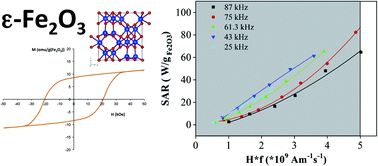Biocompatibility restrictions have limited the use of magnetic nanoparticles for magnetic hyperthermia therapy to iron oxides, namely magnetite (Fe3O4) and maghemite (γ-Fe2O3). However, there is yet another magnetic iron oxide phase that has not been considered so far, in spite of its unique magnetic properties: ε-Fe2O3. Indeed, whereas Fe3O4 and γ-Fe2O3 have a relatively low magnetic coercivity, ε-Fe2O3 exhibits a giant coercivity. In this report, the heating power of ε-Fe2O3 nanoparticles in comparison with γ-Fe2O3 nanoparticles of similar size (∼20 nm) was measured in a wide range of field frequencies and amplitudes, in uncoated and polymer-coated samples. It was found that ε-Fe2O3 nanoparticles primarily heat in the low-frequency regime (20–100 kHz) in media whose viscosity is similar to that of cell cytoplasm. In contrast, γ-Fe2O3 nanoparticles heat more effectively in the high frequency range (400–900 kHz). Cell culture experiments exhibited no toxicity in a wide range of nanoparticle concentrations and a high internalization rate. In conclusion, the performance of ε-Fe2O3 nanoparticles is slightly inferior to that of γ-Fe2O3 nanoparticles in human magnetic hyperthermia applications. However, these ε-Fe2O3 nanoparticles open the way for switchable magnetic heating owing to their distinct response to frequency.

